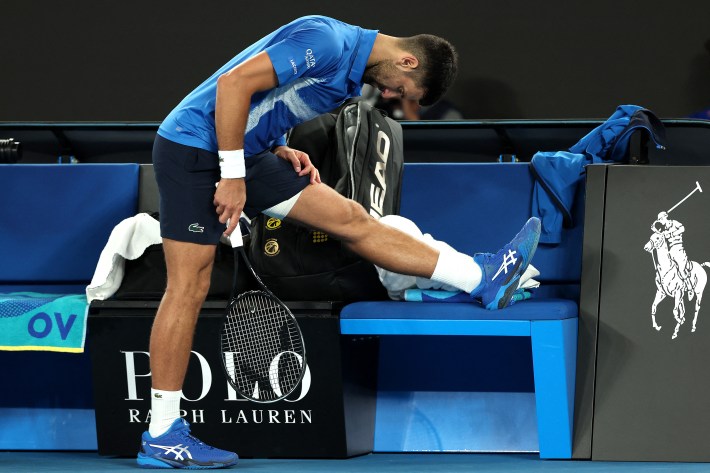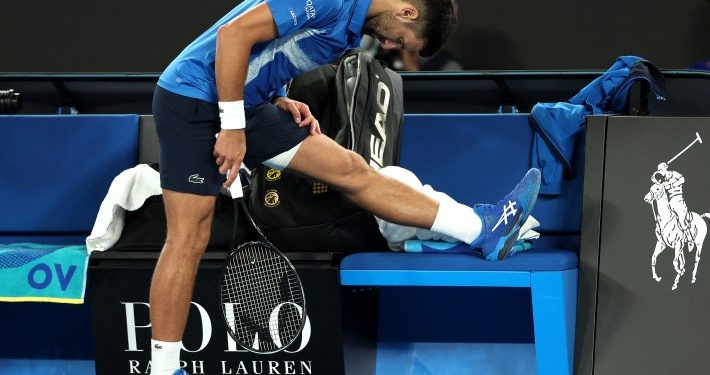Even prodigies sometimes have to learn hard lessons in public. Carlos Alcaraz has won four major titles and is extracting wisdom from tennis at a worrying rate, but there are many on-court situations that the 21-year-old has yet to face. In Tuesday’s Australian Open quarterfinal against 37-year-old Novak Djokovic, Alcaraz lost 4-6, 6-4, 6-3, 6-4 and learned to fight against an opponent whose injury didn’t stop him from playing. on a world historical level.
At 4-4 in the first set, Djokovic slipped hard while running to his right and appeared to hit something in his left groin, causing him to wince and stretch. On his next serve, he had difficulty getting off the ground with that leg. He lost the ensuing rally, then shook his head at his player’s box, suggesting he wasn’t right. An injury suddenly put the most anticipated match in the men’s draw in Melbourne in jeopardy. After breaking his serve, Djokovic was assessed by a physiotherapist, who took him off the court to bandage his left thigh. A doctor gave him a dose of painkillers. Djokovic returned to the court and lost the first set to Alcaraz, who seemed unfazed.

The second set offered a gloomy prognosis for the rest of the match. Djokovic, still compromised in his movements, began to hit the ball as hard as he could. He wouldn’t do this if he had confidence in his legs. This level of aggression is not his typical strategy, which may well be the most judicious strategy in the history of men’s tennis: a barrage of calibrated risks, upper mid-rate shots aimed at relatively safe targets, altering the trajectory of the exchange each time. he wants it, until an unambiguous opportunity to kill presents itself. Instead, he was a little itchy, taking the first possible opportunity to end the point, rather than the best. But it worked – a reminder of what a viciously clean ball striker Djokovic can be when he wants to be, how many different styles of tennis he can summon. He also served with great pace and precision, a skill that allowed him to win major tournaments even as a child.
On the other side of the field, Alcaraz seemed distracted. This is a common and somewhat counterintuitive phenomenon in tennis: one player’s injury makes the other less confident in their game plan. The uninjured player begins to think too much, to question what has been effective so far. After the match, Alcaraz reflected on what went wrong here. “Honestly, I felt like I was in control of the match and I let him get back into the match. And that’s the biggest mistake I made today,” he said . “He showed he was having trouble moving a little bit in the second set, and I had to push him a little bit more to the limit and I didn’t after that he started to get feel better.
Afterward, Djokovic said he noticed his opponent’s hesitation and tried to exploit it. “I’ve seen it and I’m trying to use that to my advantage in a sense. Take the initiative in gatherings, and your hesitations. He was at one point trying to play several drop shots and make me run,” he said. “I’ve also been in situations where the opponent is suffering from an injury but keeps going, and then you say to yourself : ‘The opponent wants everything and he stays in the match’, and then all of a sudden, as the match progresses, the opponent feels better. And then you start to panic a little with your game.”
Djokovic won the second set with this ultra-aggressive game. He felt better, the painkillers having done their job, and he began to play more like usual. In the third set, the tennis begins to scorch: a strange mix of attack and defense from two of the best contortionists of all time, like the most beautiful exchanges produced by this intergenerational rivalry, like their final of Cincinnati in 2023 or their Olympic Gold Medal Game in 2024.
Djokovic later said he was more or less unfettered from the end of the second set until the middle of the fourth, and any observer could confirm that from his performance alone. This is some of the best tennis he has played in the last five years. He was explosive and impeccable with his timing on the ball. He moved from side to side with his usual lateral movement. It was hard to imagine that this was the same player grimacing from an injury just a set ago. Maybe Alcaraz had a hard time believing it too. After losing the third set in a scandalous exchange, the Spaniard appeared to adopt a fake limp, a gesture that commentators interpreted as mockery of his opponent. After the match, however, Alcaraz was quite measured: “I’m not saying he put on a show. I’m just saying – I don’t know, it’s obvious and everyone saw it, that he struggled in the second set, and then in the third and fourth sets he showed that he was really good .
Djokovic resumed his medication at the start of the fourth set and managed to close out the match, despite a late push from Alcaraz. Djokovic said, sitting under the press, that the medication was wearing off and he was starting to feel injured sensations again. While he wouldn’t elaborate on the specific injury, he said it was very similar to the hamstring issues he experienced at the 2023 Australian Open en route to the title. But he would have two full days off to prepare for his next match, the 50th major semi-final of his career, extending his own record even further.
Before this match, Alcaraz was 55-1 in major tournaments after winning the first set. This defeat was an anomaly, and there are tactical reasons for it. In particular, it is unreal how good Alcaraz is at tennis despite the persistent imperfections of his serve, a fundamental part of the sport. The disparity on the second serve was the most glaring: Djokovic won 66% of the points on his second serve, while Alcaraz only won 44% on his own, due to their very different approaches. Djokovic hit the second serve hard, wide or straight to the body, which Alcaraz repeatedly missed into the net, never really adjusting his return position. Meanwhile, Alcaraz’s kickers on the second serve were unthreatening enough for Djokovic to hit them freely for the winning return.
But as is often the case in high-level tennis, psychological lessons could be even more constructive than raw X’s and O’s. Djokovic, who has nothing more to learn on a tennis court, expressed some empathy for his young rival. “I feel for him. I understand that it’s not comfortable to play against someone who you don’t know if he’s going to retire or not, does he move, does he run, does he he’s going to leave, what’s going on? I had the impression that he was looking at me more than he was looking at himself,” he said in press. If there’s one harsh criticism of Alcaraz at this stage of his already impressive career, it’s that he can be distracted, prone to losing his peak if anything, like an injury to a opponent, shakes his concentration. But if he manages to internalize the lesson of this match, that won’t be true for much longer.


